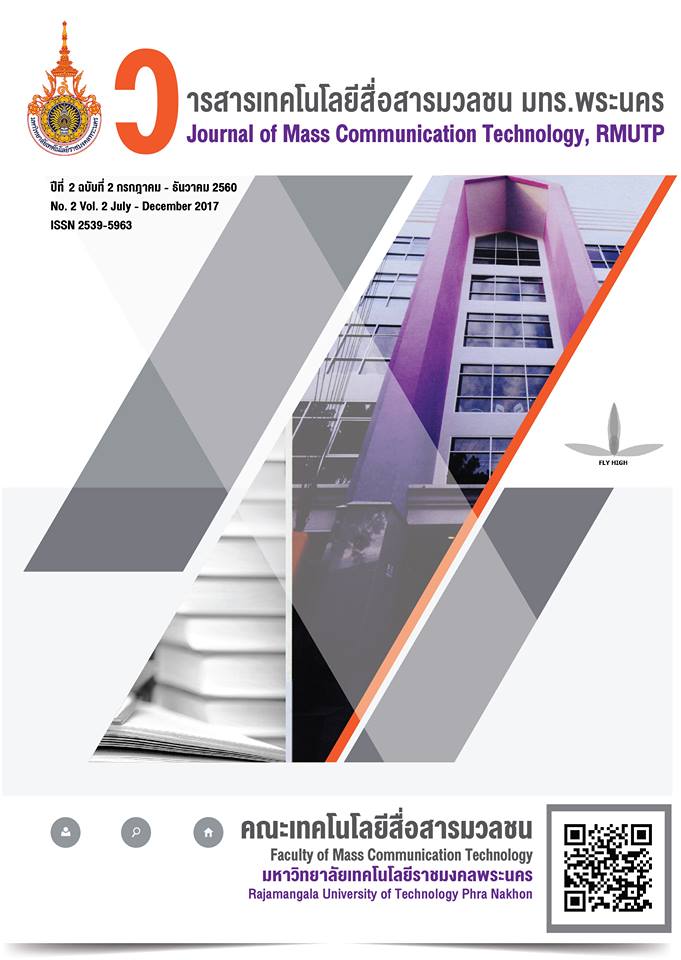การโฆษณาต่อต้านการสูบบุหรี่ที่มีเนื้อหาเชิงบวกและลบที่ส่งผลต่อการจดจำ
คำสำคัญ:
เนื้อหาเชิงบวกและเชิงลบ, โฆษณาต่อต้านการสูบบุหรี่, การจดจำบทคัดย่อ
บทความนี้มีวัตถุประสงค์เพื่อศึกษาเปรียบเทียบระหว่างเนื้อหาของโฆษณาต่อต้านการสูบบุหรี่ที่มีเนื้อหาเชิงบวก และเชิงลบที่ส่งผลต่อการจดจำของผู้รับสาร โดยศึกษาวิเคราะห์จากงานวิจัยที่มีการศึกษาทั้งในประเทศและต่างประเทศ ที่ศึกษาที่เกี่ยวข้องในเนื้อหาของโฆษณาต่อต้านการสูบบุหรี่ที่มีเนื้อหาเชิงบวกและเชิงลบที่ส่งผลกระทบต่อความจำ อีกทั้งเนื้อหาโฆษณาต่อต้านการสูบบุหรี่ที่มีเนื้อหาเชิงบวก และเชิงลบที่จะส่งผลต่อความจำของผู้ชมหรือผู้รับสารในรูปแบบที่แตกต่างกัน กล่าวคือ เนื้อหาเชิงลบเป็นเนื้อหาที่สามารถกระตุ้นผู้รับสารเกิดอารมณ์คล้อยตามในอารมณ์โกรธ กลัว เสียใจ หรือเป็นทุกข์ ให้เกิดความสนใจในเนื้อหาที่มีการนำเสนอในช่วงแรก แต่ส่งผลต่อความพึงพอใจที่มีต่อเนื้อหาของสารที่มีระดับลดลง รวมถึงส่งผลให้การเปิดรับและจดจำในเนื้อหาของสารที่ผู้รับสารในระดับที่ลดลง ส่วนเนื้อหาเชิงบวกเป็นเนื้อหาที่มีการกระตุ้นให้ผู้รับสารเกิดอารมณ์คล้อยตามในอารมณ์สนุกสนาน ความสวยงามและความผูกพัน ซึ่งเนื้อหาเชิงบวกจะส่งผลต่อผู้รับสารเกิดความพึงพอใจที่ระดับเพิ่มขึ้น แต่เนื้อหาของสารจะยังไม่ส่งผลการจดจำที่เกิดได้รวดเร็ว ทั้งนี้เมื่อเปรียบเทียบกับเนื้อหาเชิงลบ เนื้อหาโฆษณาที่มีเนื้อหาเชิงบวกจะมีเนื้อหาที่เหมาะสำหรับการใช้ในการประชาสัมพันธ์หรือจูงใจให้เกิดการปฏิบัติหรืองดเว้นจากการไม่สูบบุหรี่ได้ดีกว่าเนื้อหาในเชิงลบ โดยเฉพาะการใช้เพื่อประชาสัมพันธ์ในกลุ่มเด็กและเยาวชน
เอกสารอ้างอิง
กรุงเทพมหานคร : มหาวิทยาลัยธรรมศาสตร์.
ประภาพรรณ เอี่ยมอนันต์. (2556). [ออนไลน์]. ข้อมูลทางวิชาการเรื่องบุหรี่เท่ากับยาเสพติด. สืบค้นจาก http://www.trc.or.th/th/download/43e65296.html.
พรทิพย์ ดีสมโชค. (2550). การจดจำสารโฆษณาทางโทรทัศน์ของผู้บริโภค : (รายงานการวิจัยฉบับย่อ).
นนทบุรี : มหาวิทยาลัยสุโขทัยธรรมาธิราช.
มลินี สมภพเจริญ. (2551). “สถานการณ์การสื่อสารสุขภาพ”. วารสารสุขศึกษา. 31(2), 1-11.
มูลนิธิรณรงค์เพื่อการไม่สูบบุหรี่. (2559). [ออนไลน์]. ลำดับเหตุการณ์สำคัญของการควบคุมการสูบบุหรี่
ของไทย. สืบค้นจาก http://www.ashthailand.or.th/th/about_page.php?id=227.
มูลนิธิสถาบันวิจัยและพัฒนาองค์กรภาครัฐ (IRDP). (2558). โครงการศึกษาแนวทางในการจัดเก็บข้อมูลพฤติกรรมการใช้บริการกิจการกระจายเสียงและกิจการโทรทัศน์ (Audience Measurement). (รายงานฉบับสมบูรณ์ (Final Report)). กรุงเทพมหานคร : มูลนิธิสถาบันวิจัยและพัฒนาองค์กรภาครัฐ (IRDP).
ราตรี สุดทรวง และวีระชัย สิงหนิยม. (2550). ประสาทสรีรวิทยา. กรุงเทพมหานคร : โรงพิมพ์แห่งจุฬาลงกรณ์มหาวิทยาลัย.
มีชัย ศรีใส. (2554). NEROATOMY ประสาทภายวิภาคศาสตร์. กรุงเทพมหานคร : Year Book Publishher.
สำนักงานพัฒนานโยบายสุขภาพระหว่างประเทศ. (2557). รายงานภาระโรคและการบาดเจ็บของประชากรไทย พ.ศ.2554. นนทบุรี : มูลนิธิเพื่อพัฒนานโยบายสุขภาพระหว่างประเทศ.
สำนักงานสถิติแห่งชาติ. (2558). สรุปผลที่สำคัญการสํารวจพฤติกรรมการสูบบุหรี่และการดื่มสุราของประชากร พ.ศ. 2557. กรุงเทพมหานคร : สำนักงานสถิติแห่งชาติ.
Bajde, Domen, & Vida, Irena. (2008). “The Impact of Ad Characteristics on Adolescents’ Attitudes Towards Antismoking Ads”. Managing Global Transitions, 6(1), 75-93.
Cataldo, J., K., Hunter, M., Petersen, A., B., & Sheon, N. (2015). “Positive and instructive anti-smoking messages speak to older smokers : a focus group study.” Tobacco Inducted Diseases, 13(2), 1-8.
Cowan, N. (2008). “What are the differences between long-term, short-term, and working memory?” Prog Brain Res, 168, 323-338.
Durkin, S. J., Biener, L., & Wakefield, A. (2009). “Effects of Different Types of Antismoking Ads on Reducing Disparities in Smoking Cessation Among Socioeconomic Subgroups.” American Journal of Public Health. 12(9), 2217-2223.
Gerring, R. J., & Zimbordo, P. G. (2005). Psychology and Life. MA: Person.
Gibbsa, M., E., Hutchinson, D., & Hertz, L. (2008). “Astrocytic involvement in learning and memory consolidation.” Neuroscience and Biobehavioral Reviews, 32.
Goldstein, E., B. (2011). Cognitive Psychology: Connecting Mind, Research, and Everyday Experience. Belmont. CA: Wadsworth.
Hasselmo, M., E., & Mccleeland, J., L. (1999). “Neural Model of Memory.” Neurobiology, 9, 184-188.
Krathwohl, D. R. (2002). “A revision of bloom’s taxonomy: an overview.” Theory into practice, 41(4), 212-218.
Leshner, G., Bolls, P., & Wise, K. . (2011). “Motivated Processing of Appeal and Disgust Image in Televised Anti-Tobacco Ads.” Journal of Media Psychology, 23(2), 77-89.
Lukowiak, K., Adatia, N., Krygier, D., & Syed, N. (2000). “Operant Conditioning inLymnaea: Evidence for Intermediate- and Long-term Memory.” Learning & Memory, 7(3), 140-150.
McDougall, G. J. . (2002). “Memory Improvement in octogenarians.” Applied Nursing Research, 15(1), 2-10.
National Cancer Institute. (2008). The Role of the Media in Promoting and Reducing Tobacco Use.Tobacco Control Monograph No. 19. Bethesda. MD: National Institutes of Health, National Cancer Institute.
Pechmann, C., & Knight, S., J. . (2002). “An Experimental Investigation of the Joint Effects of Advertising and Peer on Adolescents’ Beliefs and Intentions about Cigarette Consumption.” Journal of consumerresearch, 29(1), 5-19.
Sachs, K. (2010). “Up in smoke: how antismoking advertisements have changed youth smoking habits.” The elon journal of undergraduate research in communications., 1(1), 58-69.
Schar, E., Gutierrez, K., Murphy-Hoefer, R., & Nelson, D. E. (2006). Tobacco Use Prevention Media Campaigns : Lessons Learned From Youth in Nine Countries. Atlanta : U.S.Department of Health and Human. Atlanta: U.S. Department of Health and Human Services, Centers for Disease Control and Prevention.
Schiffman, L., G., & Kanuk, . L., L. (2007). Consumer Behavior. New Jersey: Prentice-Hall.
Sutton, M. A., Bagnall, M. W., Sharma, S. K., Shobe, J., & Carew, T. J. (2004). “Intermediate-term memory for site-specific sensitization in aplysiaIs maintained by persistent activation of protein kinase c.” The journal of neuroscience, 24(14), 3600-3609.
Villaruel, J., E. . (2013). “Anti Smoking Advertisement's Message Valence : An Evaluation of Its Effectiveness to College Student Smokers.” The Macrotheme Review A multidisciplinary journal of global macro trends. 2(7), 169-177.
Wakefield, M., Flay, B., Nichter, M., & Giovino, G. (2003). “Effects of Anti-Smoking Advertising on Youth Smoking : A Review.” Journal of Health Communication, 8(3), 229-247.
White, V., Tan, N., Wakefield, M., & Hill, D. (2003). Do adult focused anti-smoking campaigns have an Impact on adolescents? the case of the Australian. Available from :
URL: https://tobaccocontrol.bmj.com.
Williams, Kaylene, C. (2012). “Improving fear appeal ethics. ” Journal of Academic and Business Ethics. 5, 1-24.
ดาวน์โหลด
เผยแพร่แล้ว
รูปแบบการอ้างอิง
ฉบับ
ประเภทบทความ
สัญญาอนุญาต
Copyright (c) วารสารเทคโนโลยีสื่อสารมวลชน มทร.พระนคร
วารสารเทคโนโลยีสื่อสารมวลชน มทร.พระนคร อยู่ภายใต้การอนุญาต Creative Commons Attribution-NonCommercial-NoDerivatives 4.0 International License. (CC BY-Nc-ND 4.0) เว้นแต่จะระบุไว้เป็นอย่างอื่น โปรดอ่านหน้านโยบายของเราสำหรับข้อมูลเพิ่มเติมเกี่ยวกับการเข้าถึงแบบปิด ลิขสิทธิ์ และการอนุญาต




